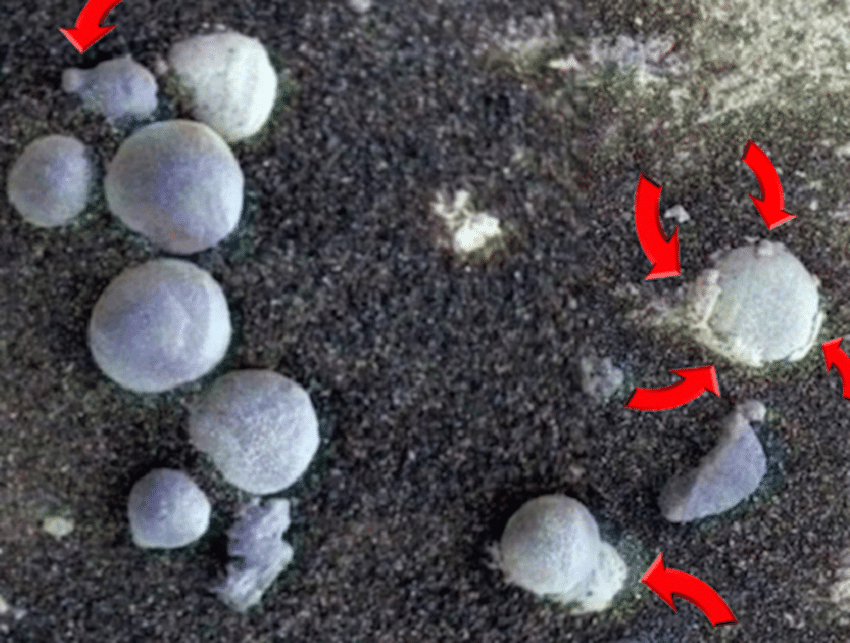Since we wrote this last year, a NEW “Fungi on Mars” study “popped up” – here’s the abstract:
Fungi thrive in radiation intense environments. Sequential photos document that fungus-like Martian specimens emerge from the soil and increase in size, including those resembling puffballs (Basidiomycota). After obliteration of spherical specimens by the rover wheels, new sphericals-some with stalks-appeared atop the crests of old tracks. Sequences document that thousands of black arctic “araneiforms” grow up to 300 meters in the Spring and disappear by Winter; a pattern repeated each Spring and which may represent massive colonies of black fungi, mould, lichens, algae, methanogens and sulfur reducing species. Black fungi-bacteria-like specimens also appeared atop the rovers. In a series of photographs over three days (Sols) white amorphous specimens within a crevice changed shape and location then disappeared. White protoplasmic-mycelium-like-tendrils with fruiting-body-like appendages form networks upon and above the surface; or increase in mass as documented by sequential photographs. Hundreds of dimpled donut-shaped “mushroom-like” formations approximately 1mm in size are adjacent or attached to these mycelium-like complexes. Additional sequences document that white amorphous masses beneath rock-shelters increase in mass, number, or disappear and that similar white-fungus-like specimens appeared inside an open rover compartment. Comparative statistical analysis of a sample of 9 spherical specimens believed to be fungal “puffballs” photographed on Sol 1145 and 12 specimens that emerged from beneath the soil on Sol 1148 confirmed the nine grew significantly closer together as their diameters expanded and some showed evidence of movement. Cluster analysis and a paired sample ‘t’ test indicates a statistically significant size increase in the average size ratio over all comparisons between and within groups (P = 0.011). Statistical comparisons indicates that arctic “araneiforms” significantly increased in length in parallel following an initial growth spurt. Although similarities in morphology are not proof of life, growth, movement, and changes in shape and location constitute behavior and support the hypothesis there is life on Mars. https://www.researchgate.net/publication/351252619_Fungi_on_Mars_Evidence_of_Growth_and_Behavior_From_Sequential_Images

This study from last year compiles a bunch of miscellaneous indirect evidence for simpler lifeforms on Mars:
“Evidence is reviewed which supports the hypothesis that prokaryotes and eukaryotes may have colonized Mars. One source of Martian life, is Earth. A variety of species remain viable after long term exposure to the radiation intense environment of space, and may survive ejection from Earth following meteor strikes, ejection from the stratosphere and mesosphere via solar winds, and sterilization of Mars-bound spacecraft; whereas simulations studies have shown that prokaryotes, fungi and lichens survive in simulated Martian environments-findings which support the hypothesis life may have been repeatedly transferred from Earth to Mars. Four independent investigators have reported what appears to be fungi and lichens on the Martian surface, whereas a fifth investigator reported what may be cyanobacteria. In another study, a statistically significant majority of 70 experts, after examining Martian specimens photographed by NASA, identified and agreed fungi, basidiomycota (“puffballs”), and lichens may have colonized Mars. Fifteen specimens resembling and identified as “puffballs” were photographed emerging from the ground over a three day period. It is possible these latter specimens are hematite and what appears to be “growth” is due to a strong wind which uncovered these specimens-an explanation which cannot account for before and after photos of what appears to be masses of fungi growing atop and within the Mars rovers. Terrestrial hematite is in part fashioned and cemented together by prokaryotes and fungi, and thus Martian hematite may also be evidence of biology. Three independent research teams have identified sediments on Mars resembling stromatolites and outcroppings having micro meso and macro characteristics typical of terrestrial microbialites constructed by cyanobacteria. Quantitative morphological analysis determined these latter specimens are statistically and physically similar to terrestrial stromatolites. Reports of water, biological residue discovered in Martian meteor ALH84001, the seasonal waning and waxing of atmospheric and ground level Martian methane which on Earth is 90% due to biology and plant growth and decay, and results from the 1976 Mars Viking Labeled Release Experiments indicating biological activity, also support the hypothesis that Mars was, and is, a living planet. Nevertheless, much of the evidence remains circumstantial and unverified, and the possibility of life on Mars remains an open question.”
https://www.researchgate.net/publication/331811325_Evidence_of_Life_on_Mars




